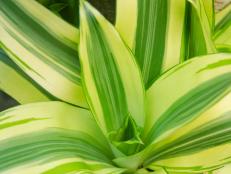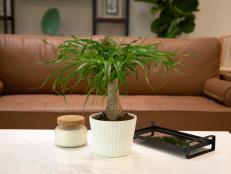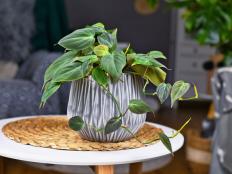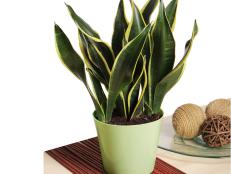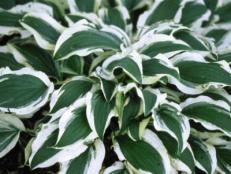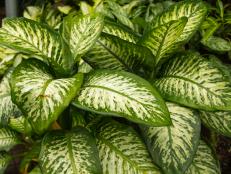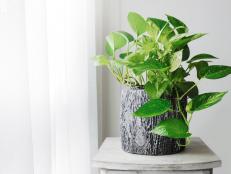Prayer Plant Care
Prayer plants put on a show at night, when they fold up their attractive leaves like praying hands. Pot up these charming houseplants for tabletops or hanging baskets.
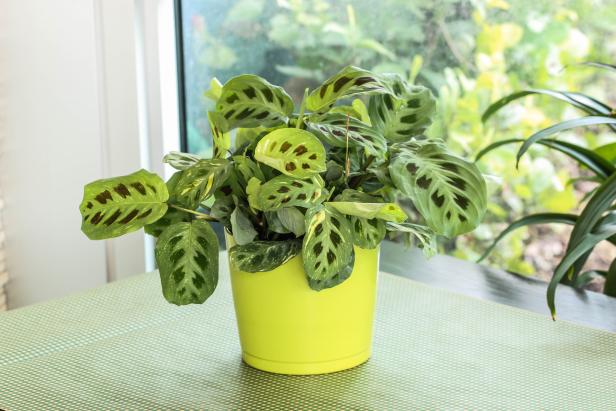
Costa Farms
'Kim' is a prayer plant variety with handsome green and yellow variegated leaves.

Plants naturally lean toward the light, but prayer plants behave in a more unusual way. At night, their leaves, which are usually horizontal, move up to look like hands folded in prayer. During the day, the leaves go back down. Although some of these plants move more slowly than others, it's thought they evolved this way to direct water toward their roots or protect themselves from hungry insects or temperature changes.
Types of Prayer Plants
Prayer plants are in the Marantaceae, or arrowroot, family. Four genera are often grown as houseplants: Maranta, Ctenanthe, Stromanthe and Goeppertia (many Goeppertia species were once classified as Calathea and are still sold by that name).
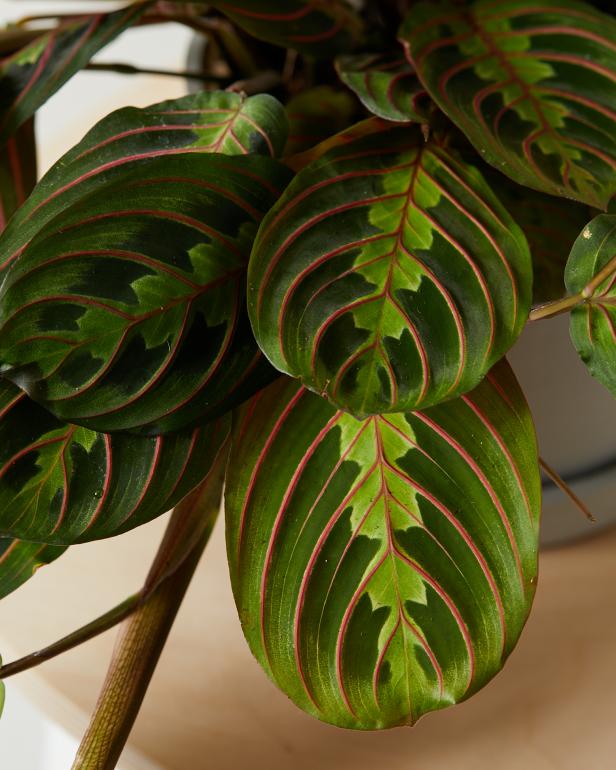
Bloomscape
Prayer plants can grow 6 to 12 inches wide and tall. Shown here: red prayer plant.
Native to the rainforests of tropical and South America, prayer plants are grown for their decorative leaves. They may bloom occasionally, but prayer plant flowers are small and insignificant. Some gardeners remove them to encourage the plant to put more energy into its colorful foliage.
30 Indoor Plants for Low Light 31 Photos
These houseplants — including payer plant — are perfect for homes and offices with low natural sunlight.
There are many types of prayer plants. Maranta leuconeura plants are widely available and very popular. Most have a slow, low and spreading growth habit that makes them ideal for containers or hanging baskets.
Growing and Caring for Prayer Plants
In the wild, these plants grow under trees, so they've adapted to low, medium or bright indirect light. Keep them out of direct sunlight, which will burn them. If they're near a window, use a sheer curtain to filter the sun. You may see more variegation on the plant's leaves when it gets bright indirect light.
Prayer plants are primarily grown as houseplants because they're hardy outdoors only in Zones 11-12. These tropicals grow best when daytime temperatures are between 65 and 75 degrees during the day, and when nighttime temperatures drop no lower than 55 to 60 degrees.
Prayer plants don't need pruning, although you can trim them just above the leaf nodes to encourage them to grow in a different direction.
Water Consistently
Prayer plants like moist soil, so water them with room temperature water when the top 25% of the soil is dry. Don't let the soil get soggy or leave them standing in water, which can cause root rot. If you keep a saucer under your plant, dump out any excess after you water.
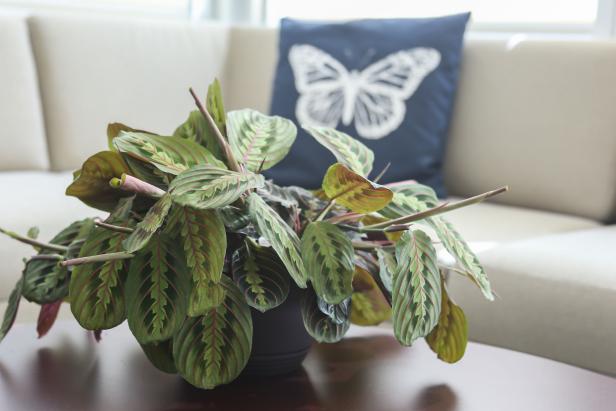
Costa Farms
High humidity keeps prayer plants happy and healthy and discourages pests like spider mites.
Fertilize
Prayer plant varieties can be fed with a general-purpose houseplant fertilizer every couple of weeks when they're actively growing in the spring or summer and fall. Stop fertilizing in winter. Follow the directions on your product for how much to apply.
Provide Humidity
Prayer plants love humidity, so mist them regularly — even daily — or keep them in a humid kitchen or bathroom. You can also run a humidifier or group plants together to raise the surrounding humidity. Another option: Place them on trays filled with pebbles and a little water. Don't let the bottom of the pots touch the water; again, this can lead to root rot.
Scout for Health Issues
Don't overwater, which can make your plant's leaves turn yellow and drop. Brown, dry leaf tips are usually a sign that the plant needs more humidity.
Fading or scorched-looking leaves indicate your plant is getting too much sun. If the leaves don't completely open during the day, your plant probably needs more light.
Avoid fungal diseases by using containers with good drainage holes and a well-draining potting mix.
Choosing Which Prayer Plant to Grow
Popular prayer plant varieties include:
- Maranta leuconeura 'Kim' - The leaves of this low-growing plant are green with creamy white streaks and purple spots.
- Maranta leuconeura 'Marisela' - This trailing prayer plant variety has dark green leaves highlighted by cream or lighter green herringbone marks.
- Maranta leuconeura var. erythroneura 'Lemon Lime' - True to its name, the leaves of 'Lemon Lime' prayer plant are various shades of green with lemon-lime markings. It resembles the red prayer plant, but its veins are bright green, not red.
- Maranta leuconeura var. erythroneura - Also known as Red Prayer Plant, this beauty has olive-green leaves and red veins.
- Maranta leuconeura var. leuconeura - Also called black prayer plant, this tropical has silver-blue foliage with purple splotches along the central veins.
- Maranta leuconeura var. 'kerchoveana' - Sometimes called rabbit's track, rabbit's foot or green prayer plant, this variety has bright green leaves with dark green, reddish-brown or purplish splotches along the leaf spines.
- Maranta leuconeura var. 'Silver Feather' - Also known as black prayer plant, this beauty has areas of grayish blue-green on its greenish-black leaves.
- Maranta leuconeura var. 'Erythroneura' - Admired for its glossy, dark green leaves, this variety, also called red prayer plant, has red veins and lighter green markings.
How to Propagate Prayer Plants
Propagating prayer plants can be done by division in early spring. Simply separate the roots gently and repot the divisions in potting mix with good drainage.
You can also take stem cuttings and root them in the spring or early summer. Make the cuttings slightly below the nodes near the bottom of the stems. Each cutting should have some leaves.
Put the cuttings in trays filled with a mixture of moist peat and perlite. Cover them with plastic to raise the humidity, but make a few small holes so air can circulate. Keep them in a sunny spot out of direct sunlight.
You can propagate pieces of prayer plants that break off in the same way. Place the broken ends in a glass of water and change it every other day. When inch-long roots form, move the pieces into a container of soil. If you prefer, dip the broken ends into rooting hormone and start them directly in soil.
Prayer Plant Pests
Spider mites, aphids and mealybugs occasionally attack prayer plants. Deter them in the first place by keeping your plant misted or in a place with high humidity.
If pests do show up, try knocking off the aphids or spider mites with a gentle spray of water from your kitchen hose or wipe both sides of the leaves with a damp cloth.
To banish mealybugs, wipe both sides of the leaves with a cotton ball dipped in rubbing alcohol. Use a cotton swab dampened with rubbing alcohol for hard-to-reach places.
If the pests come back, spray the plant with an organic pesticide such as neem oil. Repeat as needed.







